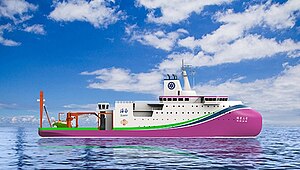Tan Suo San Hao
 Shipyard's visualization of Tan Suo San Hao
| |
| History | |
|---|---|
| Name | Tan Suo San Hao |
| Operator | Institute of Deep-sea Science and Engineering |
| Builder | Guangzhou Shipyard International (Guangzhou, China) |
| Cost | ¥800 million |
| Yard number | 22110017[3] |
| Launched | 20 April 2024 |
| Completed | 2025 (planned) |
| Identification | IMO number: 1024637[1][2] |
| Status | Launched |
| General characteristics | |
| Type | Research vessel |
| Tonnage | |
| Displacement | About 10,000 t (9,800 long tons) |
| Length | 104 m (341 ft) |
| Beam | 19.7 m (65 ft) |
| Draft | 7 m (23 ft) |
| Ice class | Polar Class 4 |
| Installed power | 4 × Wärtsilä 6L32 (4 × 3,000 kW) |
| Propulsion | Diesel-electric; two ABB Azipod DI1400 units (2 × 4.5 MW) |
| Speed | 16 knots (30 km/h; 18 mph) |
| Range | 15,000 nautical miles (28,000 km; 17,000 mi) |
| Crew | 80 |
Tan Suo San Hao (simplified Chinese: 探索三号; traditional Chinese: 探索三號; lit. 'Discovery Three') is a Chinese icebreaking research vessel under construction for the Institute of Deep-sea Science and Engineering of the Chinese Academy of Sciences.
As of 2024[update], Guangzhou Shipyard International is building a slightly smaller Polar Class 6 research vessel, Ji Di, at the same time.
Design[edit]
Tan Suo San Hao measures 104 metres (341 ft) in length overall and 19.7 metres (65 ft) in beam, draws 7 metres (23 ft) of water, and displaces about 10,000 tonnes (9,800 long tons).[1][4] The vessel has a multidisciplinary scientific outfit with accommodation for up to 80 persons as well as ability to deploy China's deep-sea research submersibles Striver, Deep Sea Warrior, and Jiaolong.[4] A 6 by 4.8 metres (20 by 16 ft) moon pool allows deploying and recovering autonomous underwater vehicles in ice-covered waters.[5]
Tan Suo San Hao's diesel-electric propulsion system consists of four 3,000-kilowatt (4,000 hp) six-cylinder Wärtsilä 6L32 main diesel generators that power the ship's two 4.5-megawatt (6,000 hp) ABB Azipod DI1400 azimuth thrusters.[1][6] This will give the vessel a maximum speed of 16 knots (30 km/h; 18 mph) in open water and enables it to break 1.2-metre (3.9 ft) level ice with a 20-centimetre (7.9 in) snow cover at a continuous speed of 2 knots (3.7 km/h; 2.3 mph) in both ahead and astern directions.[4][7]
Tan Suo San Hao is built to Polar Class 4,[7] an ice class intended for year-round operation in thick first-year ice which may contain small inclusions of old sea ice that has survived at least one melting season without melting completely.[8]
History[edit]
Development and construction[edit]
Tan Suo San Hao is claimed to be the first research vessel of its kind developed indigenously in China.[5] The ¥800 million ship has been jointly funded by the People's Government of Hainan, Sanya Yazhou Bay Science and Technology City, and the vessel's future operator, Institute of Deep Sea Science and Engineering of the Chinese Academy of Sciences.[4][7]
The construction of the vessel began with a steel cutting ceremony at Guangzhou Shipyard International, a subsidiary of the China State Shipbuilding Corporation, on 25 June 2023 and Tan Suo San Hao was floated out on 20 April 2024.[3][4]
Career[edit]
Tan Suo San Hao is planned to enter service in 2025.[4]
References[edit]
- ^ a b c "GUANGZHOU 22110017 (1024637)". Sea-web. S&P Global. Retrieved 21 April 2024.
- ^ "GUANGZHOU 22110017 (1024637)". Equasis. Ministry of Ecology, Sustainable Development and Energy. Retrieved 21 April 2024.
- ^ a b "中国首艘深远海多功能科学考察及文物考古船开工建造" [Construction of China's first deep-sea multi-functional scientific investigation and cultural relics archaeological ship begins]. Huaxia Jingwei (in Chinese). 26 June 2023. Retrieved 21 April 2024.
- ^ a b c d e f "我国首艘深远海多功能科学考察及文物考古船在中国船舶广船国际出坞" [My country's first deep-sea multi-functional scientific investigation and cultural relics archaeological ship launched]. Institute of Deep-sea Science and Engineering, CAS (in Chinese). 21 April 2024. Retrieved 21 April 2024.
- ^ a b "中国首艘深远海科考及文物考古船在广州开工" [China's first deep-sea scientific research and cultural relics archaeological ship starts construction in Guangzhou]. Jiemian (in Chinese). 26 June 2023. Retrieved 21 April 2024.
- ^ "ABB Process Automation". LinkedIn. Retrieved 21 April 2024.
Another step forward for ice-going vessels. ABB has successfully delivered the first 4500 kW Azipod® DI1400 units for PC4-rated Polar research icebreaker for shipyard installation.
- ^ a b c "ABB wins Azipod deal for polar research vessel". Ship & Offshore. 1 September 2023. Retrieved 21 April 2024.
- ^ Unified Requirements for Polar Class ships Archived 2012-06-20 at the Wayback Machine. International Association of Classification Societies (IACS), April 2016. Retrieved 2024-02-16.
